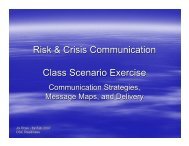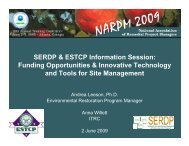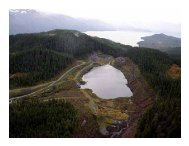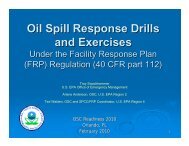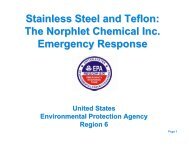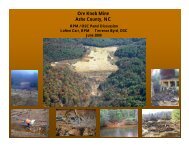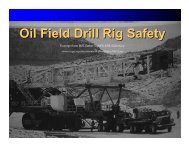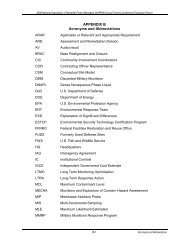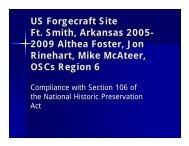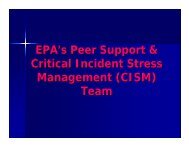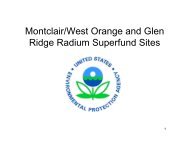Introduction to CERCLA 103, EPCRA & CAA 112(r)
Introduction to CERCLA 103, EPCRA & CAA 112(r)
Introduction to CERCLA 103, EPCRA & CAA 112(r)
- No tags were found...
You also want an ePaper? Increase the reach of your titles
YUMPU automatically turns print PDFs into web optimized ePapers that Google loves.
<strong>Introduction</strong> <strong>to</strong><strong>CERCLA</strong> <strong>103</strong>, <strong>EPCRA</strong> &<strong>CAA</strong> <strong>112</strong>(r)OSC ReadinessSan Diego, CaliforniaFebruary 20091
Course Overview• 3½ hour course• Focused on regula<strong>to</strong>ry & legislative requirements related<strong>to</strong>:– Notification for hazardous chemical releases– Community emergency planning– Chemical accident prevention• Provides an overview of requirements of:– Section <strong>103</strong> of the Comprehensive Environmental Response,Compensation, and Liabilities Act (<strong>CERCLA</strong>)– Emergency Planning and Community Right-<strong>to</strong>-Know Act(<strong>EPCRA</strong>)– <strong>CAA</strong> section <strong>112</strong>(r) (the EPA Risk Management Program)2
<strong>Introduction</strong>s• Instruc<strong>to</strong>r <strong>Introduction</strong>s– Lynn Beasley – EPA HQ– Sicy Jacob – EPA HQ– Jim Belke – EPA HQ– Kim Jennings – EPA HQ– Steve Mason – EPA Region 6• Student <strong>Introduction</strong>s3
Course Objectives• Learn types of facilities subject <strong>to</strong> <strong>CERCLA</strong>section <strong>103</strong>, <strong>EPCRA</strong> & RMP• Understand chemical lists & threshold quantitiestriggering applicability & common exemptions• Learn actions that chemical facilities must take<strong>to</strong> comply with <strong>CERCLA</strong> section <strong>103</strong>, <strong>EPCRA</strong> &RMP• Understand how other agency’s hazardouschemical regulations may relate <strong>to</strong> or affect afacility’s obligations under EPA’s regulations4
Comprehensive EnvironmentalResponse, Compensation, andLiability Act (<strong>CERCLA</strong>)section <strong>103</strong> – NotificationRequirements5
Statu<strong>to</strong>ry & Regula<strong>to</strong>ry Background• <strong>CERCLA</strong> (1980)– Reportable Quantity (RQ) Adjustments (1985)– Reporting Continuous Releases of HazardousSubstances (1990)• Superfund Amendments andReauthorization Act (SARA) (1986)– Emergency and Hazardous ChemicalInven<strong>to</strong>ry Forms and Community Right-<strong>to</strong>-Know Reporting Requirements (1987)6
The Big Picture• CERLCA– Identifies sites that may warrant Superfund response action– Mandates notification <strong>to</strong> federal authorities in case of accidentsor emergencies• <strong>EPCRA</strong>– Mandates notification <strong>to</strong> state & local authorities in case ofaccidents or emergencies7
The Basics: Reporting a Release<strong>CERCLA</strong> ReportableRelease(Hazardous Substance)<strong>EPCRA</strong> Reportable Release(Hazardous Substance orEHS)Call NRCImmediately(40 CFR §302.6(a))Call SERC & LEPCImmediately(40 CFR §355.40(b)(1))Newspaper Notice<strong>CERCLA</strong> §111(g)Written Follow-upEmergency Notice40 CFR 355.40(b)(3)8
<strong>CERCLA</strong> & <strong>EPCRA</strong>Notification Requirements• <strong>CERCLA</strong> §<strong>103</strong>– Any person in charge of a vessel or an onshore or offshorefacility shall, as soon as he has knowledge of any release…of ahazardous substance from such vessel or facility in quantityequal <strong>to</strong> or exceeding the reportable quantity…in any 24-hourperiod, immediately notify the NRC• 1-800-424-8802 or 202-267-2675• <strong>EPCRA</strong> §304– Any facility at which a hazardous chemical is produced, used ors<strong>to</strong>red and at which there is a release of a reportable quantityof any extremely hazardous substance (EHSs) or <strong>CERCLA</strong>hazardous substance…shall immediately notify the LEPC andSERC40 CFR §§302.6(a) & 355.40(a)9
What is a Facility?40 CFR §§302.3 & 355.2011
What is a Facility?• Under <strong>CERCLA</strong>, a facility is defined as:– Any building, structure, installation, equipment, pipeor pipeline, well, pit, pond, lagoon, impoundment,ditch, landfill, s<strong>to</strong>rage container…(§101(9))• Under <strong>EPCRA</strong>, a facility is defined as:– All buildings, equipment, structures, and otherstationary items that are located on a single site or oncontiguous or adjacent sites and that are owned oroperated by the same person (§329)12
What is a Release?• Release means any spilling,leaking, pumping, pouring,emitting, emptying, discharging,injecting, escaping, leaching,dumping or disposing in<strong>to</strong> theenvironment…<strong>CERCLA</strong> §101(22), 40 CFR §302.3; <strong>EPCRA</strong> §304, 40 CFR §355.2013
Is This in<strong>to</strong> the Environment?•A release directly <strong>to</strong>– Land–AirIn<strong>to</strong> the Environment– Water•A release that is– Wholly enclosedNot In<strong>to</strong> the Environment14
Is This In<strong>to</strong> the Environment?• A non-volatile spill <strong>to</strong>an impermeablesurface• Placement in<strong>to</strong> anunenclosed structure15
Controlled Releases• Disposal in landfills– RCRA Subtitle C– RCRA Subtitle D–TSCA• Discharge <strong>to</strong> apublicly ownedtreatment works(POTWs)16
Aggregating Releases• All releases of same substance fromsingle facility in any 24 hour period mustbe aggregated <strong>to</strong> determine whether anRQ has been released from facility in<strong>to</strong> theenvironment (50 FR 13456, 13459; April 4,1985)17
Aggregating Releases18
Time Period of Release• The <strong>to</strong>tal amount of hazardous substancereleased within any twenty-four hourperiod must be aggregated & comparedwith its RQ• Immediate notification required once RQ isequaled or exceeded50 FR 13456, 13463; April 4, 198563 FR 31268, 31283; June 8, 199819
• <strong>CERCLA</strong><strong>CERCLA</strong> & <strong>EPCRA</strong>Reportable Substances– Hazardous Substance Releases• <strong>EPCRA</strong>– Extremely Hazardous Substance (EHS)Releases20
<strong>CERCLA</strong> & <strong>EPCRA</strong>Reportable Substances<strong>CERCLA</strong>HazardousSubstances<strong>EPCRA</strong>EHSsNon-<strong>CERCLA</strong>EHSs21
Extremely HazardousSubstances (EHSs)• <strong>EPCRA</strong> §302 – originally chemicals inChemical Emergency PreparednessProgram (CEPP) Interim Guidance• EPA has statu<strong>to</strong>ry authority <strong>to</strong> add <strong>to</strong> or revise list<strong>EPCRA</strong> §302(a)(2)• 40 CFR 355 (Appendices A & B)22
<strong>CERCLA</strong> Hazardous Substances• <strong>CERCLA</strong> establishes list of “hazardous substances”– Approximately 800 specific substances & 1,500 radionuclides– Identified under other statutes• Clean Water Act (CWA)• Clean Air Act (<strong>CAA</strong>)• Toxic Substances Control Act (TSCA)• Resource Conservation and Recovery Act (RCRA)– Authority <strong>to</strong> designate (add <strong>to</strong> list) – <strong>CERCLA</strong> section 102• Substances which, when released in<strong>to</strong> environment may presentsubstantial danger <strong>to</strong> public health or welfare or environment• 40 CFR 302.4 – List of Hazardous Substances andReportable Quantities23
<strong>CERCLA</strong> Hazardous Substances• CWA hazardous substances & <strong>CERCLA</strong>hazardous substances– All CWA hazardous substances are <strong>CERCLA</strong>hazardous substances• CWA section 311(b)(4)• CWA section 307(a)– Some <strong>CERCLA</strong> hazardous substances areCWA hazardous substances24
<strong>CERCLA</strong> Hazardous Substances• How does EPA choose chemical name(s)<strong>to</strong> list for each substance on List ofHazardous Substances (40 CFR 302.4)?– Use name from environmental statutes &implementing regulations– If more than one name, each chemical namewill appear as separate entry (with same CASRegistry Number)• Column of regula<strong>to</strong>ry synonyms removed in 200225
<strong>CERCLA</strong> Hazardous Substances:Hazardous Wastes• Listed wastes– Dangerous Waste Discarded Chemical Products – P & U (40 CFR §261.33)• Specific commercial chemical products in unused form• Some pesticides & pharmaceutical products become hazardous waste when discarded– Nonspecific Source Wastes – F (40 CFR §261.31)• Wastes from common manufacturing & industrial processes (e.g., solvents used incleaning or degreasing operations)• Known as wastes from non-specific sources because processes producing thesewastes can occur in different sec<strong>to</strong>rs of industry– Source Specific Wastes – K (40 CFR §261.32)• Wastes from specific industries (e.g., petroleum refining or pesticide manufacturing)• Certain sludges & wastewaters from treatment & production processes in theseindustries• Unlisted/characteristic wastes – 100 pound RQ– Ignitability (D001)– Corrosivity (D002)– Reactivity (D003)– Toxicity (D004 – D043) – See Table 302.426
<strong>CERCLA</strong> Hazardous Substances:Hazardous Wastes• Releases of wastes that are not individually listed as<strong>CERCLA</strong> hazardous substances• <strong>CERCLA</strong> reporting requirements apply <strong>to</strong> wastes orwaste streams exhibiting characteristics of ignitability,corrosivity, reactivity or <strong>to</strong>xicity under RCRA• Release of a non-designated substance exhibiting any ofthese four RCRA characteristics is release of ahazardous substance if substance is a waste prior <strong>to</strong>release or becomes a waste after release• Under RCRA regulations, substance becomes wasteafter release if it is not cleaned up or if it is cleaned uponly for eventual disposal27
<strong>CERCLA</strong> Hazardous Substances:Hazardous Wastes• Tests <strong>to</strong> determine whether waste exhibitsRCRA characteristic of <strong>to</strong>xicity– Toxicity characteristic leaching procedure(TCLP)• Extract contains any of 25 organic constituentslisted in regulations at or above specified levels[55 FR 11876, Mar. 29, 1990]• Au<strong>to</strong>matically RCRA hazardous wastes and,therefore, <strong>CERCLA</strong> hazardous substances28
<strong>CERCLA</strong> Hazardous Substances:Hazardous Wastes & the Mixture Rule• Releases of mixtures or solutions(including hazardous waste streams) ofhazardous substances are subject <strong>to</strong>notification requirements, if quantity of allhazardous constituents are known, wherean RQ or more of any hazardousconstituent is released (40 CFR §302.6(b))29
<strong>CERCLA</strong> Hazardous Substances:Hazardous Wastes & the Mixture Rule• Mixture rule versus RQ for wastelisting– If exact composition of waste stream isknown, report when constituent isreleased in excess of its RQ– If exact composition of waste stream isunknown, report when <strong>to</strong>tal quantityreleased exceeds RQ for waste streamlisting30
<strong>CERCLA</strong> Hazardous Substances:Hazardous Wastes & the Mixture Rule• Special hazardous wastes – EPA providesconstituent information for certain waste streamsIfWaste stream is specifically designated in40 CFR §302.6(b)(1)(iii)ThenAssume maximum constituent concentrations (as listed)Apply mixture rule31
Reportable Quantities• Reportable quantity (RQ) is amount of hazardoussubstance or EHS that must be released within twentyfourhours <strong>to</strong> trigger notification• <strong>CERCLA</strong> establishes statu<strong>to</strong>ry one-pound RQ for allhazardous substances that did not already have RQsestablished under CWA– EPA adjusted those RQs by regulation <strong>to</strong> establish final RQs– Substance evaluated based on intrinsic properties: chemical,physical, <strong>to</strong>xicological– After evaluating substance, EPA promulgates final RQ– RQs found in U.S. Code of Federal Regulations – 40 CFR 302• List of Hazardous Substances and Reportable Quantities32
Reportable Quantities• EPA established final RQ for each hazardoussubstance that are not radionuclides– Hazardous substance final RQs established at 1, 10,100, 1,000 or 5,000 pounds– Radionuclide final RQs expressed in curies &established at 0.001, 0.01, 0.1, 1, 10, 100 or 1,000curies– RQs serve as reporting triggers• No RQ established for generic classes (e.g.,chlorinated benzenes, phthalate esters, etc.)33
Reportable Quantities• Generic classes of compounds– No established RQs for CWA generic classes ofcompounds that are <strong>CERCLA</strong> hazardous substances– Not reportable unless there is an individual listing• Haloethers (generic class)• Propane, 2,2’-oxybis[2-chloro-] (individual listing)– Remain subject <strong>to</strong> response (section 104), abatement(section 106) & liability (section 107) provisions under<strong>CERCLA</strong>34
Continuous Release Reporting• <strong>CERCLA</strong> section <strong>103</strong>(f)(2)– Reduced reporting for continuous releases of hazardoussubstances that exceed RQ• Continuous– Occurs without interruption or abatement, or is– Routine, anticipated & intermittent during normal operations ortreatment processes• Stable in quantity & rate– Predictable & regular in amount & rate of emission– Notification given once• Unless change in source or composition of release, change innormal range of release or change in other reported information– Follow-up report on first anniversary of initial report– Report statistically significant increases35
Continuous Release Reporting• Statistically significant increase– Any release of hazardous substance thatexceeds upper bound of reported normalrange of continuous release• Normal Range– All releases of hazardous substance reportedor occurring over any 24-hour period undernormal operating conditions during precedingyear36
SummaryRelease Notification<strong>CERCLA</strong>√√√ReleaseHazardous Substance≥ RQ√√√ReleaseHazardous Substance or EHS≥ RQ<strong>EPCRA</strong>√From a Vessel or Facility√From a Facility√Within any 24-Hour Period√Within any 24-Hour Period‣ Notify NRC‣ Notice in Local Newspaper‣ Notify SERC & LEPC‣ Written Follow-up37
Not a Facility• Household Exclusion– <strong>CERCLA</strong> definition of facility specifically excludes consumer products inconsumer use• <strong>EPCRA</strong> applicability requires facility <strong>to</strong> produce, use or s<strong>to</strong>rehazardous chemical– Hazardous chemical definition excludes household products40 CFR §§302.3, 355.20 & 370.238
Not a Release:Federally Permitted Release• Federally permitted releases are notsubject <strong>to</strong> release notification• Includes discharges in compliance withfollowing permits– CWA NPDES– CWA dredged or fill material– RCRA– CWA ocean dumping– SDWA UIC– <strong>CAA</strong>– State injection– State NPDES– AEA39
Not a Release:Federally Permitted Releases• Clean Air Act (<strong>CAA</strong>) Permits– Emission limitations– Technology requirements– Operational requirements• Guidance on federally permitted releases for certain air releases(67 FR 18899; April 17, 2002)– VOC, PM & NO X– Minor sources– Waivers, accidents & malfunctions– Start-up & shut-down• Discharges in excess of federally permitted limits– Do not qualify as federally permitted releases– RQ calculations begin at the point at which release exceedspermit40
Not a Release• Any release which results in exposure <strong>to</strong>persons solely within workplace• Emissions from engine exhaust of mo<strong>to</strong>rvehicle, rolling s<strong>to</strong>ck, aircraft, vessel orpipeline pumping station engine• Certain releases of source, byproduct orspecial nuclear material from nuclearincident• Normal application of fertilizers41
Not a Hazardous Substance• Petroleum Exclusion– The term hazardous substance does notinclude petroleum, including crude oil or anyfraction there of which is not specifically listedor designated as a hazardous substance(<strong>CERCLA</strong> §101(14))42
Not a Hazardous Substance:Petroleum Exclusion• The term petroleumincludes:– Crude oil or any fractionthereof including anyhazardous substanceindigenous <strong>to</strong> substance (e.g.,benzene)– Hazardous substances thatare normally mixed with oradded <strong>to</strong> crude oil duringrefining process43
Not a Hazardous Substance:Petroleum Exclusion• The term petroleum does notinclude:– Hazardous substances that areadded <strong>to</strong> petroleum or that increasein concentration as a result ofcontamination (e.g., PCBs)44
Statu<strong>to</strong>ry Exemptionsfrom Reporting• <strong>CERCLA</strong> section <strong>103</strong>– <strong>103</strong>(e): Application of pesticide productregister under the Federal Insecticide,Fungicide, and Rodenticide Act (FIFRA) orhandling or s<strong>to</strong>rage of such product by anagricultural producer– <strong>103</strong>(f): Release of substance that is required<strong>to</strong> be reported (or exempted from reporting)under RCRA Subtitle C & has already beenreported <strong>to</strong> NRC under Subtitle C regulations45
Regula<strong>to</strong>ry Exemptionsfrom Reporting• Regula<strong>to</strong>ry exemptions from reporting under <strong>CERCLA</strong> section <strong>103</strong>– Certain solid metals when diameter of released metal equals or exceeds100 micrometers• Antimony, arsenic, beryllium, cadmium, chromium, copper, lead, nickel,selenium, silver, thallium & zinc– Administrative Reporting Exemptions• Radionuclides– Naturally occurring from large generally undisturbed land holdings (e.g., golfcourses & parks)– Naturally occurring from the disturbance of large areas of land for purposes otherthan mining (e.g., farming or building construction)– Dumping of coal & coal ash at utility & industrial facilities with coal-fired boilers– Coal & coal ash piles at utility & industrial facilities with coal-fired boilers• Nitrogen Oxide (NO) & Nitrogen Dioxide (NO 2 )– Result of combustion of less than 1,000 pounds of NO & less than 1,000 poundsof NO 2<strong>to</strong> air in 24 hours.» Each of these hazardous substances has an RQ of 10 pounds.• Air Releases of Hazardous Substances from Animal Waste at Farms– Full exemption under <strong>CERCLA</strong> section <strong>103</strong> notification requirements– Limited exemption under <strong>EPCRA</strong> section 304 emergency notificationrequirements46
Release Notification:<strong>CERCLA</strong> ExemptionsPetroleum exclusionConsumer productEngine exhaust frommo<strong>to</strong>r vehiclesNuclear incidentNormal application offertilizerNormal application ofpesticideFederally permitted releasesSolid particles (>100 microns)of certain metalsCertain radionuclide releasesReleases <strong>to</strong> RCRA Subtitle CfacilitiesQualified NOx Emissions47
Release Notification:<strong>EPCRA</strong> ExemptionsHousehold productEngine exhaust frommo<strong>to</strong>r vehiclesNuclear incidentNormal application offertilizerRelease solely withinfacility boundariesNormal application ofpesticideFederally permitted releasesCertain radionuclide releasesQualified NOx Emissions48
Relationship Between <strong>CERCLA</strong>Liability & Reporting• Failure <strong>to</strong> comply with <strong>CERCLA</strong> section <strong>103</strong> notificationrequirements may result in fines, per offense, of up <strong>to</strong>$37,500 and prison sentences of up <strong>to</strong> three years (or up<strong>to</strong> five years for second and subsequent convictions)• Proper & timely reporting of release in accordance with<strong>CERCLA</strong> section <strong>103</strong> does not preclude liability forcleanup costs, natural resource damages & costs of anynecessary health studies conducted under <strong>CERCLA</strong>section 104(i)• A release of <strong>CERCLA</strong> hazardous substance below itsRQ does not preclude liability from any damages thatmay result (including cleanup costs or natural resourcedamages)49
How DOT relates <strong>to</strong> <strong>CERCLA</strong>• <strong>CERCLA</strong> section 306(a) – Transportation ofhazardous substances; listing as hazardousmaterials; liability for release– Department of Transportation (DOT) required <strong>to</strong> list ®ulate as hazardous materials all <strong>CERCLA</strong>hazardous substances• All <strong>CERCLA</strong> hazardous substances covered by DOT’sHazardous Materials Regulations– Materials shipped in quantities equal <strong>to</strong> or greater than theirRQs– Present in single package, above certain concentrationthresholds– Must be identified as such on shipping papers & by packagemarkings50
Questions?51
Emergency Planning andCommunity Right-<strong>to</strong><strong>to</strong>-Know Act(<strong>EPCRA</strong>)52
Bhopal, IndiaDecember 198453
Institute, West VirginiaAugust 198554
<strong>EPCRA</strong>• Section 301: Establishment of State Emergency ResponseCommissions (SERCs), emergency planning districts &Local Emergency Planning Committees (LEPCs)• Section 302: Substances & Facilities Covered & Notification (40CFR part 355)• Section 303: Comprehensive Emergency Response Plans• Section 304: Emergency Notification (40 CFR part 355)• Section 311 & 312: Hazardous Chemical Inven<strong>to</strong>ry Reporting (40 CFR part370)• Section 313: Toxic Chemical Release Reporting (40 CFR 372)• Section 321: Relationship <strong>to</strong> Other Law• Section 322: Trade Secrets (40 CFR part 350)• Section 323: Provision of Information <strong>to</strong> Health Professionals, Doc<strong>to</strong>r& Nurses• Section 324: Public Availability of Plans, Data Sheets, Forms &Follow-up Notices• Section 325: Enforcement• Section 326: Civil Actions• Section 327: Exemption• Section 328: Regulations• Section 329: Definitions55
<strong>EPCRA</strong>• Emergency Planning Framework & EmergencyResponse Planning– Sections 301 & 303• Emergency Planning Notification– Section 302• Emergency Release Notification– Section 304• Hazardous Chemical Inven<strong>to</strong>ry Reporting– Sections 311 & 312• Toxic Chemical Inven<strong>to</strong>ry Reporting– Section 313 (managed by OEI/TRI)56
Establishment of State Commissions, PlanningDistricts & Local Committees (section 301)• Governors establish StateEmergency ResponseCommissions (SERCs)• SERCs designate emergencyplanning districts and appointmembers of the LocalEmergency PlanningCommittees (LEPCs) foreach planning district• Members of LEPCs include representatives from followinggroups & organizations:– Elected State & local officials, law enforcement, civil defense, firefighting, first aid, health, local environmental, hospital,transportation personnel, media, community groups, owners &opera<strong>to</strong>rs of facilities subject <strong>to</strong> requirements, etc.57
Emergency Planning Notification(section 302)Applicability & Exemptions:• Applicable <strong>to</strong> any facility that has an ExtremelyHazardous Substance (EHS) present at any timeat or above its Threshold Planning Quantity(TPQ)– (EHSs & their TPQs are codified in 40 CFR part 355)Exemptions:• Only substances in transportation or s<strong>to</strong>redincident <strong>to</strong> transportation are excluded from thissection58
Emergency Planning Notification(section 302)• Section 302(b)(2) gives Governor or SERCauthority <strong>to</strong> designate additional facilities assubject <strong>to</strong> emergency planning provisions afterpublic notice & comment– Facilities may be designated under this authority evenif all substances present at facility qualify fortransportation exemption at section 327; &– Substances that are not EHSs at these designatedfacilities may become subject <strong>to</strong> emergency planningrequirements59
Emergency Planning Notification(section 302)Facility Requirements:• One-time notification (first notification was required by May 17, 1987)<strong>to</strong> SERC & LEPC if any EHS is present in an amountequal <strong>to</strong> or greater than its TPQ– 60 days after facility becomes subject <strong>to</strong> requirements• Designate facility emergency coordina<strong>to</strong>r• Changes relevant <strong>to</strong> emergency planning must beprovided <strong>to</strong> LEPC within 30 days of such changes– (changes may include, but are not limited <strong>to</strong>, EHSs are no longerpresent at facility, EHSs are moved <strong>to</strong> new location, facility is no longerin operation, etc.)• Must provide any information necessary for developing &implementing local emergency plan60
Threshold Determination forEmergency Planning Notification• Aggregate <strong>to</strong>tal amount of an EHS in pure formand in mixtures (concentration of EHS greater than 1%)present throughout facility at any one time <strong>to</strong>determine if that EHS exceed its TPQExample:Chemical A (EHS) = 100 pounds &Mixture 1 (Chemical A = 50%, Chemical B =50%) = 1,000 pounds. TPQ for Chemical A is500 poundsTotal amount of Chemical A = 100 pounds + (50% of 1,000 pounds) =600 pounds (exceeds TPQ)Therefore, facility should inform their SERC & LEPC that facility issubject <strong>to</strong> emergency planning61
Emergency Response Plans(section 303)• LEPC required <strong>to</strong> develop an emergencyresponse plan for their community• Plan should be reviewed annually or morefrequently if changes occur• LEPCs have authority <strong>to</strong> request anyinformation from facility necessary fordeveloping & implementing emergencyresponse plan62
Elements of Emergency Response Plans(section 303(c))• Emergency plan should include, but arenot limited <strong>to</strong>, each of the following:– Identification of facilities subject <strong>to</strong> requirements that are withinemergency planning district– Identification of routes likely <strong>to</strong> be used for transportation of substanceson EHSs– Identification of additional facilities contributing or subjected <strong>to</strong> additionalrisk due <strong>to</strong> their proximity <strong>to</strong> facilities subject <strong>to</strong> requirements of thissubtitle, such as hospitals or natural gas facilities– Methods & procedures <strong>to</strong> be followed by facility owners & opera<strong>to</strong>rs &local emergency & medical personnel <strong>to</strong> respond <strong>to</strong> any release of suchsubstances– Designation of community emergency coordina<strong>to</strong>r & facility emergencycoordina<strong>to</strong>rs, who shall make determinations necessary <strong>to</strong> implementplan63
Elements of EmergencyResponse Plans• Procedures providing reliable, effective & timely notification byfacility emergency coordina<strong>to</strong>rs & community emergencycoordina<strong>to</strong>r <strong>to</strong> persons designated in emergency plan, & <strong>to</strong>public, that a release has occurred• Methods of determining occurrence of release & area orpopulation likely <strong>to</strong> be affected by such release• A description of emergency equipment & facilities in community& at each facility in community subject <strong>to</strong> requirements & anidentification of persons responsible for such equipment &facilities• Evacuation plans, including provisions for precautionaryevacuation & alternative traffic routes• Training programs, including schedules for training of localemergency response & medical personnel• Methods & schedules for exercising emergency plan64
Emergency Release Notification(section 304)• Applicable if both of these conditions aremet:– Facility at which hazardous chemical isproduced, used or s<strong>to</strong>red; and– which there is release of a reportablequantity (RQ) of any extremely hazardoussubstance (EHS) or <strong>CERCLA</strong> hazardoussubstance65
Emergency Release Notification(section 304)• <strong>EPCRA</strong> notification is in addition <strong>to</strong><strong>CERCLA</strong> release notificationrequirements:– SERC & LEPC (State or area likely <strong>to</strong> be affected byrelease)– Written follow-up of the notification (as soon aspracticable after release)– Notify 911 or opera<strong>to</strong>r for transportationrelated-releases (SERC or LEPC phone numbers arenot available)66
<strong>EPCRA</strong> section 304Reportable Substances<strong>CERCLA</strong>HazardousSubstancesEHSs67
<strong>EPCRA</strong> section 304 Exemptions• What is different from <strong>CERCLA</strong>?–NoPetroleum exclusion (if any EHSs are present inany petroleum product, notification under <strong>EPCRA</strong> section 304will apply)– Do not need <strong>to</strong> report releases solely withinfacility boundaries• All other <strong>CERCLA</strong> exemptions apply <strong>to</strong><strong>EPCRA</strong> section 30468
<strong>EPCRA</strong> Release Notification:Reporting a Release<strong>EPCRA</strong> ReportableRelease(<strong>CERCLA</strong> HazardousSubstance or EHS)Call SERC & LEPCImmediately(40 CFR §355.42)Written FollowupEmergencyNotice(40 CFR §355.42)69
Hazardous Chemical Reporting(sections 311 & 312) 40 CFR part 370Applicability:• Hazardous Chemicals (chemicals that require anMSDS) defined under OSHA HazardCommunication Standard (HCS), whichinclude EHSs• Exemptions under OSHA HCS• Exemptions under section 311(e)• Transportation Exemption (section 327)70
Exemptions under OSHA HCS• Examples of few exemptions underOSHA HCS:– Hazardous Waste: Hazardous waste is exemptedfrom the standard when subject <strong>to</strong> RCRA regulations– Consumer Products: Windshield wiper fluid for cars(however, an employee using windshield wiper fluid on a dailybasis is not exempt)– Articles: Stainless steel table, tires, adhesive tape, etc.For more details on these & other exemptions,see 29 CFR part 1910.120 (www.osha.gov)71
<strong>EPCRA</strong> section 311(e) Exemptions• Although OSHA HCS MSDS requirements may apply <strong>to</strong> thesesubstances, these are excluded from <strong>EPCRA</strong> sections 311 & 312:– Any food, food additive, color additive, drug or cosmetic regulated bythe Food and Drug Administration (e.g., chlorine <strong>to</strong> bleach flour)– Any substance present as solid in any manufactured item <strong>to</strong> extentexposure <strong>to</strong> substance does not occur under normal conditions of use(e.g., sheets of metal in s<strong>to</strong>rage)– Any substance <strong>to</strong> extent it is used for personal, family or householdpurposes, or is present in same form & concentration as productpackaged for distribution & use by general public (e.g., heating fuel at homesbut not in business buildings)– Any substance <strong>to</strong> extent it is used in research labora<strong>to</strong>ry or hospital orother medical facility under direct supervision of technically qualifiedindividual (e.g., chemicals in school lab under supervision of science teacher)– Any substance <strong>to</strong> extent it is used in routine agricultural operations or isfertilizer held for sale by retailer <strong>to</strong> ultimate cus<strong>to</strong>mer (e.g., ammonia used asfertilizer by farmer)72
Hazardous Chemical Reporting(sections 311 & 312)Thresholds:• EHSs – 500 lbs or TPQ whichever is less• Gasoline – 75,000 gallons (at retail gas station, s<strong>to</strong>redentirely underground, in compliance at all times in previous calendar yearwith UST requirements)• Gasohol (90% gasoline & 10% ethanol) –75,000 gallons (at retail gas station, s<strong>to</strong>red entirely underground, incompliance at all times in previous calendar year with UST requirements)• Diesel – 100,000 gallons (at retail gas station, s<strong>to</strong>red entirelyunderground, in compliance at all times in previous calendar year with USTrequirements)• All other hazardous chemicals – 10,000 lbs73
Thresholds(sections 311 & 312)• Alternative Fuels (Ethanol & Methanolmixtures…E85, E95, M85), aviation fuel,heating fuel, kerosene:– Threshold for these substances (non-EHShazardous chemicals) is 10,000 pounds74
Hazardous Chemical Reporting• Two parts <strong>to</strong> hazardous chemical reporting:– Material safety data sheet (MSDS) reporting• One-time reporting requirement– Hazardous chemical inven<strong>to</strong>ry reporting• Annual hazardous chemical inven<strong>to</strong>ry due by March 175
Hazardous Chemical Reporting(section 311)Requirements:• Submit MSDS or list of hazardous chemicals grouped byhazard category that meet or exceed applicablethresholds <strong>to</strong> following three entities:– State Emergency Response Commission (SERC)– Local Emergency Planning Committee (LEPC)– Local Fire Department with jurisdiction over facility• One-time submission• Supplemental Reporting – Information on new chemicals& significant new information on already submittedchemicals – must be provided within 3 months76
Mixtures (section 311)• Submit MSDS for each component ofmixture or include list of hazardouscomponents of mixtureOR• Submit MSDS for mixture or includemixture itself on list of chemicals77
Hazardous Chemical Reporting(section 312)• Section 312 – Submit Inven<strong>to</strong>ry form (Tier I/Tier II orState form – paper form) for all hazardous chemicalspresent at facility at any time during previouscalendar year in an amount equal <strong>to</strong> or in excessof applicable thresholds. Report is due March 1annually– SERC–LEPC– Local fire department with jurisdiction over facility• Tier2 Submit or State Electronic format78
Mixtures (section 312)• If mixture contains hazardous chemicalthat is an EHS:– Aggregate <strong>to</strong>tal amount of EHS present inpure form & in mixtures <strong>to</strong> determine if itexceeded reporting threshold– Facility may report EHS on inven<strong>to</strong>ry form orreport mixture• Reporting must be consistent with MSDS or listreporting under section 31179
Mixtures (section 312)• If mixture contains hazardous chemicalsthat is not an EHS:– Choose <strong>to</strong> either aggregate non-EHShazardous chemical present throughoutfacility or <strong>to</strong>tal quantity of that mixture presentthroughout facility– Report non-EHS hazardous chemical ormixture on inven<strong>to</strong>ry form• Reporting must be consistent with MSDS or listreporting under section 31180
Exercise #1A facility has five significantly different mixtures that allcontain Aldicarb (116-06-3), an EHS. None of individualmixtures exceeds 500 pound threshold for Aldicarb.Does facility have <strong>to</strong> report anything?AldicarbA B C D50 lbs. 200 lbs. 450 lbs. 5 lbs.81
Exercise #2A facility wants <strong>to</strong> know about its reporting obligationsunder <strong>EPCRA</strong> sections 311 & 312. It is required <strong>to</strong> have &maintain MSDSs under OSHA for two mixtures, A & B,that are present at facility. The chemicals in mixtures arenot otherwise present at facility. What chemicals mustfacility report under <strong>EPCRA</strong> sections 311 & 312?MIXTURE Adicro<strong>to</strong>phos – 60 poundscreosote – 5,000 poundsMIXTURE Bdicro<strong>to</strong>phos – 90 poundscreosote – 6,000 pounds82
Exercise #3A facility wants <strong>to</strong> know whethersilver (7440-22-4) is reportableunder <strong>EPCRA</strong> sections 311 & 312.The facility has 7,000 pounds ofpure silver & also has 10,000pounds of a mixture that contains25% silver by weight. Is facilitysubject <strong>to</strong> reporting under <strong>EPCRA</strong>sections 311 & 312?83
Trade Secrets (section 322)• Any facility may withhold specific chemicalidentity of EHS or hazardous chemical reportedunder sections 303(d)(2), 303(d)(3), 311 or 312– Regulations 40 CFR part 350– Substantiation <strong>to</strong> accompany claims must besubmitted <strong>to</strong> EPA– May release chemical specific information <strong>to</strong> localgovernment personnel, doc<strong>to</strong>rs, nurse, healthprofessional provided that they submit statement ofneed & confidentiality agreement– Medical emergency (information must be providedupon receiving statement of need)84
Public Availability (section 324)• Each emergency response plan, materialsafety data sheet, list described in section311(a)(2), inven<strong>to</strong>ry form & follow-upemergency notice shall be made available<strong>to</strong> general public shall be consistent withsection 322 (Trade Secrets)85
Questions?86
Clean Air Act (<strong>CAA</strong>)section <strong>112</strong>(r)Risk Management Program87
Legislative Background• Clean Air Act Amendments (1990)– Process Safety ManagementStandard – PSM (1992)– Risk Management Program Regulation (1994-1996)– U.S. Chemical Safety and HazardInvestigation Board – CSB (1998)– Chemical Safety Information, Site Security,and Fuels Regula<strong>to</strong>ry Relief Act –CSISSFRRA (1999)88
Clean Air Act section <strong>112</strong>(r)• Established General DutyClause• Required EPA <strong>to</strong> list atleast 100 regulatedsubstances known <strong>to</strong>cause death or seriousadverse effects <strong>to</strong> humanhealth or the environment• Required EPA <strong>to</strong> promulgate regulations & guidance <strong>to</strong>prevent, detect & respond <strong>to</strong> accidental releases ofregulated substances• Regulations <strong>to</strong> include risk management plan (RMP)available <strong>to</strong> government officials & public89
General Duty Clause• Owners & opera<strong>to</strong>rs havegeneral duty <strong>to</strong>:– Identify hazards associated withpotential accidental release of an“extremely hazardous substance”using appropriate hazardassessment techniques– Design & maintain safe facility,taking steps <strong>to</strong> prevent releases– Minimize consequences ofaccidental releases which do occur• Not limited <strong>to</strong> specific list ofchemicals or threshold quantities90
<strong>CAA</strong> section <strong>112</strong>(r)(3) –Listing Criteria• List at least 100 substances known <strong>to</strong> causedeath, injury or serious adverse effects <strong>to</strong> humanhealth or environment if accidentally released• Required EPA <strong>to</strong> use, but not be limited by,<strong>EPCRA</strong> EHS list, with appropriate modifications• 16 specific substances mandated by statute• Listing criteria– Severity of acute adverse health effects– Likelihood of accidental releases– Potential magnitude of human exposure91
Substances Mandated forListing by <strong>CAA</strong>• Chlorine• Anhydrous ammonia• Methyl chloride• Ethylene oxide• Vinyl chloride• Methyl isocyanate• Hydrogen cyanide• Ammonia• Hydrogen sulfide• Toluene diisocyanate• Phosgene• Bromine• Anhydrous hydrogenchloride• Hydrogen fluoride• Anhydrous sulfurdioxide• Sulfur trioxide92
Final List of Regulated Substances• 77 <strong>to</strong>xic & 63 flammablesubstances listed based on:– Toxicity:• Inhalation LC 50 ≤ 50 mg/L air• Dermal LD 50 ≤ 50 mg/kgbody weight• Oral LD 50 ≤ 25 mg/kg bodyweight– Ambient physical state• Gas• Liquid with vapor pressure > 10 mm Hg– Flammability: NFPA 4 flammability (Flash point < 73 o F, Boilingpoint < 100 o F)– Production volume & accident his<strong>to</strong>ry93
Mixtures & Solutions• Listed <strong>to</strong>xic mixtures containing > 1% listed <strong>to</strong>xicsubstance w/partial pressure > 10 mm Hg• Listed flammable mixtures containing > 1%listed flammable substance w/mixture exceedingNFPA 4 flammability criteria• Substances with specified concentrations:– Nitric Acid (≥80%)– Hydrofluoric Acid (≥50%)– Hydrochloric Acid (≥37%)– Aqueous Ammonia (≥20%)94
40 CFR Part 68Risk Management Program• The Risk ManagementProgram is designed <strong>to</strong>:– Prevent accidentalchemical releases <strong>to</strong> air– Minimize consequences ofreleases that do occur– Provide information aboutchemical hazards <strong>to</strong> public& government officials inorder <strong>to</strong> promote dialoguewith industry <strong>to</strong> reduce risk95
Applicability Criteria• Facilities meeting all of following criteriaare subject <strong>to</strong> 40 CFR Part 68:– Stationary source– With one or more regulated substances– Contained in aprocess– Above a thresholdquantity96
RMP Regulation – Exemptions• Transportation• Mixtures < 1% concentration (flammable & <strong>to</strong>xic)• Gasoline used as fuel for internal combustion engines• Naturally occurring hydrocarbon mixtures prior <strong>to</strong> processing• “Articles”• Specified uses:– As structural component of stationary source– For routine jani<strong>to</strong>rial maintenance– As foods, drugs, cosmetics or other personal items– In process water, non-contact cooling water, compressed air or airused for combustion• Activities in labora<strong>to</strong>ries• Anhydrous ammonia held by farmers for use as nutrient• Flammable substances used as fuel or held for retail sale• Outer continental shelf sources97
RMP Regulation – Requirements• Owner/opera<strong>to</strong>r requirements:– Conduct hazardassessment (offsiteconsequence analysis &five-year accident his<strong>to</strong>ry)– Develop managementsystem & implement anaccident preventionprogram (except Program 1 processes)– Implement an emergency response program or plan– Submit Risk Management Plan (RMP) <strong>to</strong> EPA• RMPs available <strong>to</strong> government, limited public access98
Hazard Assessment• Five Year Accident His<strong>to</strong>ry– Accidents resulting in deaths, injuries,significant property damage, evacuations,sheltering-in-place or environmental damage• Offsite Consequence Analysis– Worst-Case Release Scenario– Alternative Scenario (except Program 1)– Offsite Impacts• Residential population within endpoint distance• Presence of institutions, parks, recreational areas,major commercial, office & industrial buildings99
Simplified Illustration of Fictional Worst-Case andAlternative Release Scenarios on a Local MapSource has:2 regulated Toxic substances1 regulated Flammable substanceB AvenueC AvenueFlammable WCSSource BoundaryToxic ARS 2Toxic ARS 1A StreetRail SpurToxic WCS distance <strong>to</strong> endpoint0 1/2 1Miles100
Prevention Program Levels• Covered processes placed in<strong>to</strong> one of 3“Program Levels”– Program 1 – processes with no public recep<strong>to</strong>rs inworst case scenario zone & no significantaccidents in last five years– Program 3 – processes not eligible for P1 that arealready covered by OSHA PSM or that are withinany of 10 specified NAICS codes– Program 2 – processes not eligible for P1 & notcovered by P3101
Program 3 Prevention Requirements• Process SafetyInformation• Process HazardAnalysis• Operating Procedures• Training• Mechanical Integrity• Management ofChange• Pre-Startup Review• Compliance Audits• Incident Investigation• EmployeeParticipation• Hot Work• Contrac<strong>to</strong>rs102
Program 2 Prevention Requirements• Safety Information• Hazard Review• Operating Procedures• Training• Maintenance• Compliance Audits• Incident Investigations<strong>103</strong>
Emergency Response Program• Facilities may either use their own employees <strong>to</strong>respond or rely on public responders• Facilities that use their own employees <strong>to</strong>respond <strong>to</strong> accidental releases must have:– Written ER plan addressing response procedures,medical treatment, public & local authority notification– ER equipment inspection, testing & maintenance– Training for all employees in relevant procedures• Facilities that rely on public responders must:– Have appropriate notification mechanisms in place– Coordinate response actions with community ERplan or local fire department104
Risk Management Plans• Executive summary• Registration info: Facility ID, location, lat/long,chemical process info (e.g., NAICS, chemicalname, CAS #, quantity), etc.• 5-year accident his<strong>to</strong>ry• Accident prevention program info: hazardanalysis methods, mitigation measures, etc.• Emergency response planning information• Offsite consequence analysis: Worst-case &alternative release scenarios105
Geographic Distribution of RMP Facilities
RMP Chemical Processes~ 14,000 facilities with~ 19,000 processes containing~ 24,000 vesselsAllOthersIsobutaneButane2%Ammonia (aq)2%Sulfur Dioxide3%Propane4%FlammableMixture13%Ammonia34%Chlorine16%PentaneFormaldehyde (so)IsopentaneHydrogen FluorideAll Others107
RMP Chemical QuantitiesPropylene1%Ethane2%Ethylene2%Isobutane3%Butane11%Ammonia13%Propane14%Flammable Mixture43%There are over 75 billionpounds of hazardouschemicals regulatedunder the RMP rule2-MethylpropenePentaneChlorineVinyl Chloride1,3-ButadieneAll Others108
RMP Industry Sec<strong>to</strong>rsOther 5%Food &Beverage14%Agriculture28%Water &Wastewater16%Energy16%ChemicalManufacturing21%109
RMP Reported Accidents5004003002001000'95 '96 '97 '98 '99 '00 '01 '02 '03 '04 '05 '06 '07# Accidents110
How OSHA, DOT & DHS RegulationsRelate <strong>to</strong> RMP Program• OSHA PSM coverage determines programlevel of many RMP-covered processes• Relationship <strong>to</strong> DOT coverage:– Facilities & pipelines regulated under 49 CFRpart 192, 193 or 195 exempt from RMP– Substances in transportation or s<strong>to</strong>rageincident <strong>to</strong> transportation exempt from RMP• DHS CFATS Appendix A list, thresholds &exemptions are based in part on RMPregulations111
Questions?• For more information, visit:www.epa.gov/emergencies<strong>112</strong>



